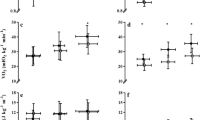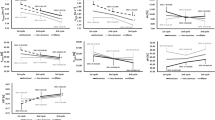Abstract
Purpose
The purpose of this study was to determine kinematic and energetic differences between front crawl and backstroke performed at the same aerobic speeds.
Methods
Ten male competitive swimmers performed front crawl and backstroke at a pre-determined sub-anaerobic threshold speed to assess energy cost (through oxygen uptake measurement) and kinematics (using three-dimensional videography to determine stroke frequency and length, intra-cycle velocity fluctuation, three-dimensional wrist and ankle speeds, and vertical and lateral ankle range of motion). For detailed kinematic analysis, resultant displacement, the duration, and three-dimensional speed of the wrist during the entry, pull, push, and release phases were also investigated.
Results
There were no differences in stroke frequency/length and intra-cycle velocity fluctuation between the swimming techniques, however, swimmers had lower energy cost in front crawl than in backstroke (0.77 ± 0.08 vs 0.91 ± 0.12 kJ m−1, p < 0.01). Slower three-dimensional wrist and ankle speeds under the water (1.29 ± 0.10 vs 1.55 ± 0.10 and 0.80 ± 0.16 vs 0.97 ± 0.13 m s−1, both p < 0.01) and smaller ankle vertical range of motion (0.36 ± 0.06 vs 0.47 ± 0.07 m, p < 0.01) in front crawl than in backstroke were also observed, which indirectly suggested higher propulsive efficiency in front crawl.
Conclusion
Front crawl is less costly than backstroke, and limbs motion in front crawl is more effective than in backstroke.




Similar content being viewed by others
Abbreviations
- 3Duankle :
-
Three-dimensional ankle speed in relation to the speed of centre of mass
- 3Duwrist :
-
Three-dimensional wrist speed in relation to the speed of centre of mass
- AnT:
-
Anaerobic threshold
- C :
-
Energy cost
- COM:
-
Centre of mass
- CV:
-
Coefficient of variation
- IVfluc :
-
Intracycle velocity fluctuation
- ROM:
-
Range of motion
- SF:
-
Stroke frequency
- SL:
-
Stroke length
- vAnT:
-
Swimming speed at anaerobic threshold intensity
- v COM :
-
Mean speed of the centre of mass during the upper limb cycle
- v inst :
-
Instructed speed
- v S :
-
Mean swimming speed during the whole testing
- \(\dot {V}{{\text{O}}_2}\) :
-
Oxygen uptake
- W int :
-
Internal work
- η F :
-
Froude efficiency
- η O :
-
Overall efficiency
- η P :
-
Propelling efficiency
References
Alexander RM (1983) Motion in fluids. In: Animal mechanics. Blackwell Scientific Publications, Oxford, pp 183–233
Alexander RM (2003) Swimming with oars and hydrofoils. Principles of animal locomotion. Princeton University Press, New Jersey, pp 249–265
Alves F, Gomes-Pereira J, Pereira F (1996) Determinants of energy cost of front crawl and backstroke swimming and competitive performance. Biomech Med Swim VII:185–191
Baldari C, Fernandes RJ, Meucci M, Ribeiro J, Guidetti L (2013) Is the new AquaTrainer® snorkel valid for VO2 assessment in swimming ? Int J Sports Med 34:336–344. https://doi.org/10.1055/s-0032-1321804
Barbosa T, Keskinen KL, Fernandes R, Colaço P, Lima AB, Vilas-Boas JP (2005) Energy cost and intracyclic variation of the velocity of the centre of mass in butterfly stroke. Eur J Appl Physiol 93:519–523. https://doi.org/10.1007/s00421-004-1251-x
Barbosa T, Fernandes RJ, Keskinen KL, Colaço P, Cardoso C, Silva J, Vilas-Boas JP (2006a) Evaluation of the energy expenditure in competitive swimming strokes. Int J Sports Med 27:894–899. https://doi.org/10.1055/s-2006-923776
Barbosa T, Lima F, Portela A, Novais D, Machado L, Colaço P, Gonçalves P, Fernades RJ, Vilas-Boas JP (2006b) Relationships between energy cost, swimming velocity, and speed fluctuation in competitive swimming strokes. Biomech Med Swim X:192–194
Barbosa T, Fernandes RJ, Keskinen KL, Vilas-Boas JP (2008) The influence of stroke mechanics into energy cost of elite swimmers. Eur J Appl Physiol 103:139–149. https://doi.org/10.1007/s00421-008-0676-z
Barbosa T, Bragada JA, Reis VM, Marinho DA, Carvalho C, Silva AJ (2010) Energetics and biomechanics as determining factors of swimming performance: updating the state of the art. J Sci Med Sport 13:262–269. https://doi.org/10.1016/j.jsams.2009.01.003
Barbosa TM, Marinho DA, Costa MJ, Silva AJ (2011) Biomechanics of competitive swimming strokes. In: Klika V (ed) Biomechanics in applications, Chapter 16. InTech, Rijeka, pp 367–388
Capelli C, Pendergast DR, Termin B (1998) Energetics of swimming at maximal speeds in humans. Eur J Appl Physiol Occup Physiol 78:385–393. https://doi.org/10.1007/s004210050435
Challis J, Bartlett RM, Yeadon M (1997) Image-based motion analysis. Biomechanical analysis of movement in sport and exercise. British Association of Sport and Exercise Sciences, Leeds, pp 7–30
Chollet D, Chalies S, Chatard JC (2000) A new index of coordination for the crawl: description and usefulness. Int J Sports Med 21:54–59. https://doi.org/10.1055/s-2000-8855
Chollet D, Seifert LM, Carter M (2008) Arm coordination in elite backstroke swimmers. J Sports Sci 26:675–682. https://doi.org/10.1080/02640410701787791
Cohen J (1988) Statistical power analysis for the behavioral sciences, 2nd edn. Lawrence Erlbaum, Hillsdale
Craig AB, Pendergast DR (1979) Relationships of stroke rate, distance per stroke and velocity in competitive swimming. Med Sci Sports 11:278–283. https://doi.org/10.1249/00005768-197901130-00011
Craig AB, Skehan PL, Pawelczyk JA, Boomer WL (1985) Velocity, stroke rate, and distance per stroke during elite swimming competition. Med Sci Sports Exerc 17:625–634. https://doi.org/10.1249/00005768-198512000-00001
Daniel TL (1991) Efficiency in aquatic locomotion: limitations from single cells to animals. In: Robert W, Blake (eds) Efficiency and economy in animal physiology. Cambridge university press, Cambridge, pp 83–96
De Jesus K, De Jesus K, Figueiredo P, Vilas-boas JP, Fernandes RJ, Machado LJ (2015) Reconstruction accuracy assessment of surface and underwater 3D motion analysis: a new approach. Comput Math Methods Med. https://doi.org/10.1155/2015/269264
Deffeyes J, Sanders R (2005) Elliptical zone body segment modeling software-Digitising, modeling and body segment parameter calculation. In: Proceedings of the 23rd international symposium on biomechanics in sports. pp 749–752
di Prampero PE (1986) The energy cost of human locomotion on land and in water. Int J Sports Med 7:55–72. https://doi.org/10.1055/s-2008-1025736
Fernandes RJ, Sousa M, Machado L, Vilas-Boas JP (2011) Step length and individual anaerobic threshold assessment in swimming. Int J Sports Med 32:940–946. https://doi.org/10.1055/s-0031-1283189
Figueiredo P, Zamparo P, Sousa A, Vilas-Boas JP, Fernandes RJ (2011) An energy balance of the 200 m front crawl race. Eur J Appl Physiol 111:767–777. https://doi.org/10.1007/s00421-010-1696-z
Figueiredo P, Barbosa T, Vilas-Boas JP, Fernandes R (2012) Energy cost and body centre of mass’ 3D intracycle velocity variation in swimming. Eur J Appl Physiol 112:3319–3326. https://doi.org/10.1007/s00421-011-2284-6
Figueiredo P, Pendergast DR, Vilas-Boas JP, Fernandes RJ (2013a) Interplay of biomechanical, energetic, coordinative, and muscular factors in a 200 m front crawl swim. Biomed Res Int 2013. https://doi.org/10.1155/2013/897232
Figueiredo P, Sanders R, Gorski T, Vilas-Boas JP, Fernandes RJ (2013b) Kinematic and electromyographic changes during 200 m front crawl at race pace. Int J Sports Med 34:49–55. https://doi.org/10.1055/s-0032-1321889
Figueiredo P, Toussaint HM, Vilas-Boas JP, Fernandes RJ (2013c) Relation between efficiency and energy cost with coordination in aquatic locomotion. Eur J Appl Physiol 113:651–659. https://doi.org/10.1007/s00421-012-2468-8
Gatta G, Cortesi M, Fantozzi S, Zamparo P (2015) Planimetric frontal area in the four swimming strokes: Implications for drag, energetics and speed. Hum Mov Sci 39:41–54. https://doi.org/10.1016/j.humov.2014.06.010
Gourgoulis V, Aggeloussis N, Vezos N, Mavromatis G (2006) Effect of two different sized hand paddles on the front crawl stroke kinematics. J Sports Med Phys Fitness 46:232–237
Grimston SK, Hay JG (1986) Relationship among anthropometric and stroking characteristics of college swimmers. Med Sci Sports Exerc 18:60–68
Jensen RK (1978) Estimation of the biomechanical properties of three body types using a photogrammetric method. J Biomech 11:349–358. https://doi.org/10.1016/0021-9290(78)90069-6
Kjendlie PL, Ingjer F, Stallman RK, Stray-Gundersen J (2004) Factors affecting swimming economy in children and adults. Eur J Appl Physiol 93:65–74. https://doi.org/10.1007/s00421-004-1164-8
Lerda R, Cardelli C (2003) Analysis of stroke organisation in the backstroke as a function of skill. Res Q Exerc Sport 74:215–219. https://doi.org/10.1080/02701367.2003.10609083
McCabe CB, Sanders R (2012) Kinematic differences between front crawl sprint and distance swimmers at a distance pace. J Sports Sci 30:601–608. https://doi.org/10.1080/02640414.2012.660186
McCabe CB, Psycharakis SG, Sanders R (2011) Kinematic differences between front crawl sprint and distance swimmers at sprint pace. J Sports Sci 29:115–123. https://doi.org/10.1080/02640414.2010.523090
McCabe CB, Sanders R, Psycharakis SG (2015) Upper limb kinematic differences between breathing and non-breathing conditions in front crawl sprint swimming. J Biomech 48:3995–4001. https://doi.org/10.1016/j.jbiomech.2015.09.012
Nigg BM (1983) Selected methodology in biomechanics with respect to swimming. Biomech Med Swim V:72–80
Pendergast DR, Mollendorf JC, Zamparo P, Termin A, Bushnell D, Paschke D (2005) The influence of drag on human locomotion in water. Undersea Hyperb Med 32:45–57
Psycharakis SG, Sanders R (2010) Body roll in swimming: a review. J Sports Sci 28:229–236. https://doi.org/10.1080/02640410903508847
Psycharakis SG, Sanders R, Mill F (2005) A calibration frame for 3D swimming analysis. In: Proceeding of the 23rd International Symposium on Biomechanics in Sport. pp 901–904
Ribeiro J, Figueiredo P, Guidetti L, Alves F, Toussaint H, Vilas-Boas JP, Baldari C, Fernandes RJ (2016) AquaTrainer® snorkel does not increase hydrodynamic drag but influences turning time. Int J Sports Med. https://doi.org/10.1055/s-0035-1555859
Sanders R, Psycharakis SG (2009) Rolling rhythms in front crawl swimming with six-beat kick. J Biomech 42:273–279. https://doi.org/10.1016/j.jbiomech.2008.10.037
Sanders R, Chiu CY, Gonjo T, Thow J, Oliveira N, Psycharakis S, Payton C, McCabe C (2015) Reliability of the elliptical zone method of estimating body segment parameters of swimmers. J Sport Sci Med 14:215–224
Seifert L, Chollet D (2009) Modelling spatial-temporal and coordinative parameters in swimming. J Sci Med Sport 12:495–499. https://doi.org/10.1016/j.jsams.2008.03.002
Smith HK, Montpetit RR, Perrault H (1988) The aerobic demand of backstroke swimming, and its relation to body size, stroke technique, and performance. Eur J Appl Physiol 58:182–188. https://doi.org/10.1007/BF00636624
Sousa A, Figueiredo P, Oliveira N, Oliveira J, Keskinen KL, Fernandes RJ (2010) Comparison between swimming VO2peak and VO2max at different time intervals. Open Sports Sci J 3:22–24. https://doi.org/10.2174/1875399X01003010022
Thevelein X, Daly D, Persyn U (1984) Measurement of total energy use in the evaluation of competitive swimmers. Curr Top Sport Med Wien Urban Schwarz 668–676
Urhausen A, Coen B, Weiler B, Kindermann W (1993) Individual anaerobic threshold and maximum lactate steady state. Int J Sports Med 14:134–139
Vilas-Boas JP, Fernandes RJ, Barbosa T (2011) Intra cycle velocity variations, swimming economy, performance, and training in swimming. In: World book of swimming: from science to performance. Nova Science Publishers Inc, New York, pp 119–134
Yanai T (2003) Stroke frequency in front crawl: its mechanical link to the fluid forces required in non-propulsive directions. J Biomech 36:53–62. https://doi.org/10.1016/S0021-9290(02)00299-3
Yanai T (2004) Buoyancy is the primary source of generating bodyroll in front-crawl swimming. J Biomech 37:605–612. https://doi.org/10.1016/j.jbiomech.2003.10.004
Zamparo P, Capelli C, Cautero M, Di Nino A (2000) Energy cost of front-crawl swimming at supra-maximal speeds and underwater torque in young swimmers. Eur J Appl Physiol 83:487–491. https://doi.org/10.1007/s004210000318
Zamparo P, Pendergast DR, Termin B, Minetti AE (2002) How fins affect the economy and efficiency of human swimming. J Exp Biol 205:2665–2676
Zamparo P, Bonifazi M, Faina M, Milan A, Sardella F, Schena F, Capelli C (2005a) Energy cost of swimming of elite long-distance swimmers. Eur J Appl Physiol 94:697–704. https://doi.org/10.1007/s00421-005-1337-0
Zamparo P, Pendergast DR, Mollendorf J, Termin A, Minetti AE (2005b) An energy balance of front crawl. Eur J Appl Physiol 94:134–144. https://doi.org/10.1007/s00421-004-1281-4
Zamparo P, Pendergast DR, Termin A, Minetti AE (2006) Economy and efficiency of swimming at the surface with fins of different size and stiffness. Eur J Appl Physiol 96:459–470. https://doi.org/10.1007/s00421-005-0075-7
Zamparo P, Capelli C, Pendergast D (2011) Energetics of swimming: a historical perspective. Eur J Appl Physiol 111:367–378. https://doi.org/10.1007/s00421-010-1433-7
Funding
This work was supported by YAMAHA Motor Foundation for Sports (YMFS) International Sport Scholarship.
Author information
Authors and Affiliations
Contributions
TG, CM, and RS conceived and designed research. TG, AS, JR, RF, and JV conducted data collection including protocol adjustment, participant recruitment, and testing. TG analysed data. TG wrote the manuscript. All authors read and approved the manuscript.
Corresponding author
Ethics declarations
Conflict of interest
The authors declare no conflicts of interest.
Additional information
Communicated by Jean-René Lacour.
Electronic supplementary material
Below is the link to the electronic supplementary material.
Rights and permissions
About this article
Cite this article
Gonjo, T., McCabe, C., Sousa, A. et al. Differences in kinematics and energy cost between front crawl and backstroke below the anaerobic threshold. Eur J Appl Physiol 118, 1107–1118 (2018). https://doi.org/10.1007/s00421-018-3841-z
Received:
Accepted:
Published:
Issue Date:
DOI: https://doi.org/10.1007/s00421-018-3841-z




